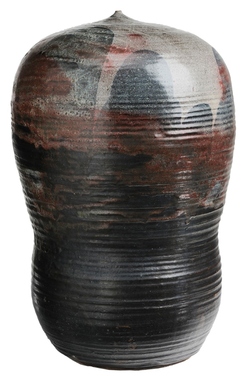In my life I see no difference between making pots, cooking, and growing vegetables. They are all so related. However there is a need for me to work in clay. It is so gratifying and I get so much joy from it, and it gives me many answers in my life.
Born in Hawaii to Japanese immigrants, Toshiko Takaezu studied at the University of Hawaii and, from 1951 to 1954, at the Cranbrook Academy of Art in Bloomfield Hills, Michigan. It was there that she met her mentor, Finnish ceramist Maija Grotell. Grotell inspired Takaezu to abandon functional ceramics and, instead, embrace ceramics as art. Into this art, she incorporated a strong Japanese aesthetic, as well as a Buddhist influence that arose from time spent at a Zen monastery in the 1950s.
Takaezu’s commitment to ceramics-as-art was solidified when she developed closed forms, most notably the moon pot, that had only very tiny openings, or sometimes no openings at all. She worked in both stoneware and porcelain, and was able to utilize these simple forms, sometimes short and squat, sometimes tall and cylindrical, to experiment with glazes in a wide variety of colors and application techniques. Later in her career, she turned away from her potter’s wheel to build pieces by hand, often to grand sizes. Although she viewed her work as a kind of poetry in clay, she also claimed it was an integral part of life for her, no different than cooking (and in fact, she used her kiln to prepare food).
Her devotion to teaching was a strong as her devotion to her art. Takaezu taught at the Cleveland Institute of Art, and for twenty-five years, at Princeton University, where she helped develop their visual arts program. She also took on apprentices regularly throughout her career.
Toshiko Takaezu was the recipient of numerous awards during her lifetime, including the designation as Hawaii Living Treasure, and her works are in the collections of dozens of museums across the country.




